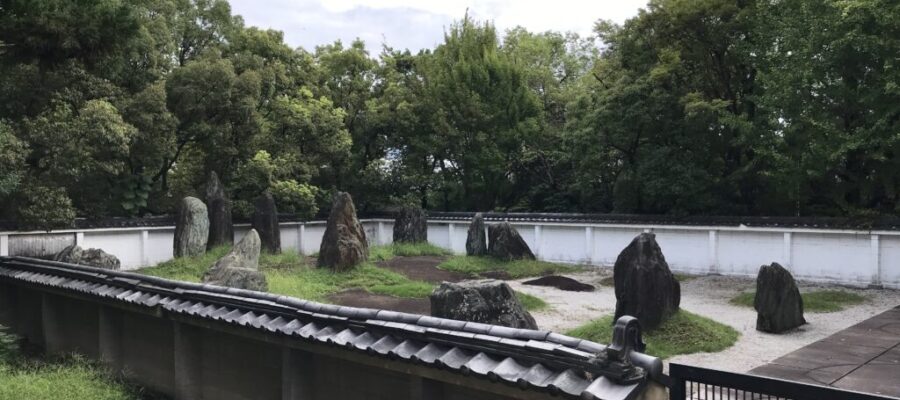大阪城に隠れた名園
以前、大阪城内にある豊臣秀吉を祀った豊国神社について書いたことがありますが、その本殿の右側奥に、知る人ぞ知る重森三玲が作庭した庭があります。残念ながら、鑑賞に来る方は皆無で、いつも入口が閉ざされています。それでも塀が低いので、塀越しに鑑賞可能です。
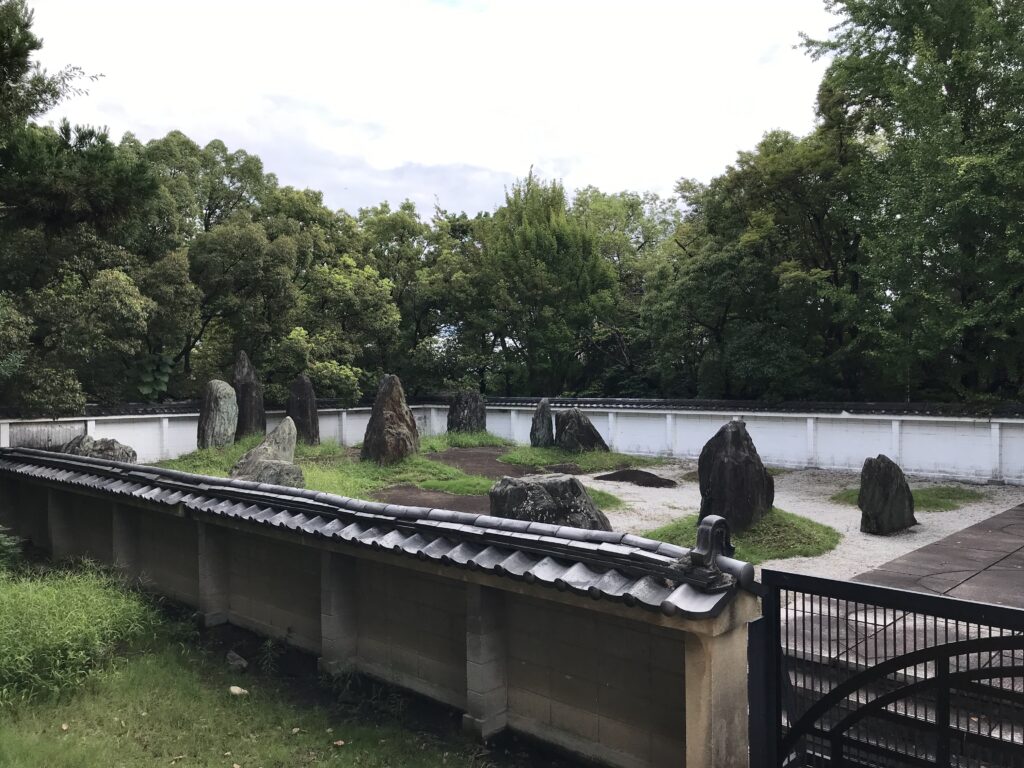
作庭家は重森三玲
この庭の名前は「秀石庭」です。豊臣秀吉の秀の字と、元々石山本願寺があった場所であり、重森三玲さんの得意な大きな石をふんだんに使った庭という意味だと思います。あまりガイドブックなどで紹介されていないと思うので、塀に掛かっている錆びついた表示板の説明だけが頼りですが、なんとも読みづらいです。
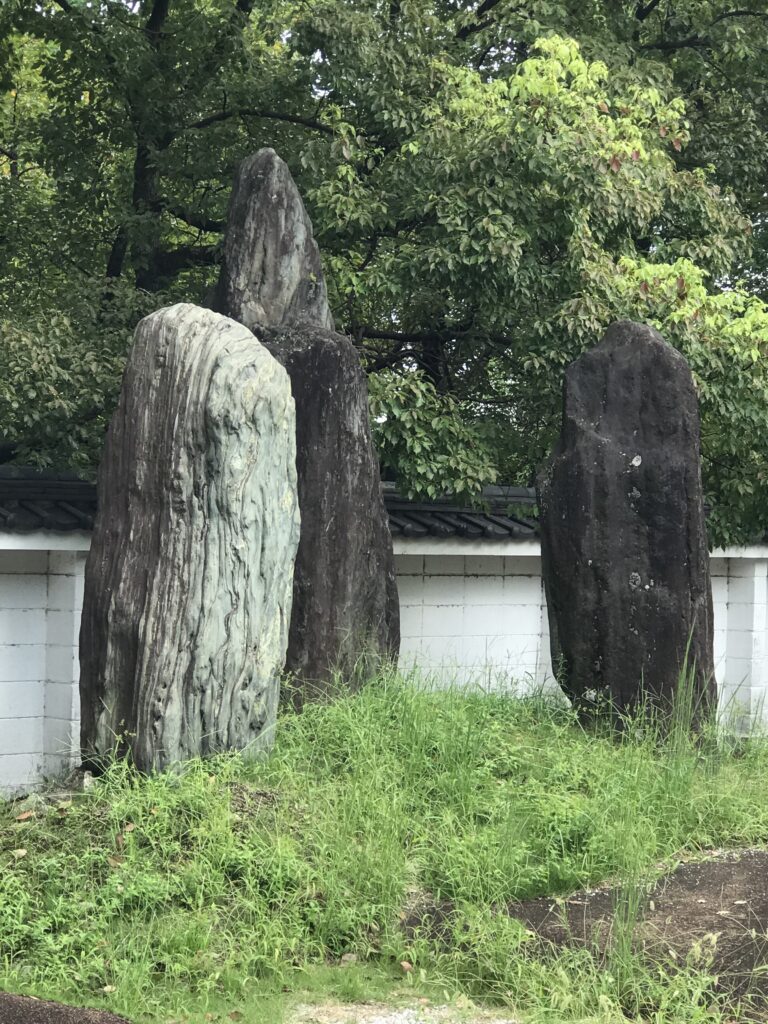
石庭ですので蓬莱山を象った石を置いてあり、秀吉のシンボルマークである大きな瓢箪を地面にデザインして、石を並べています。この石は徳島県産の緑泥片岩だそうで、重森三玲が会心の庭を設計したときのために、保存させてあった巨石です。
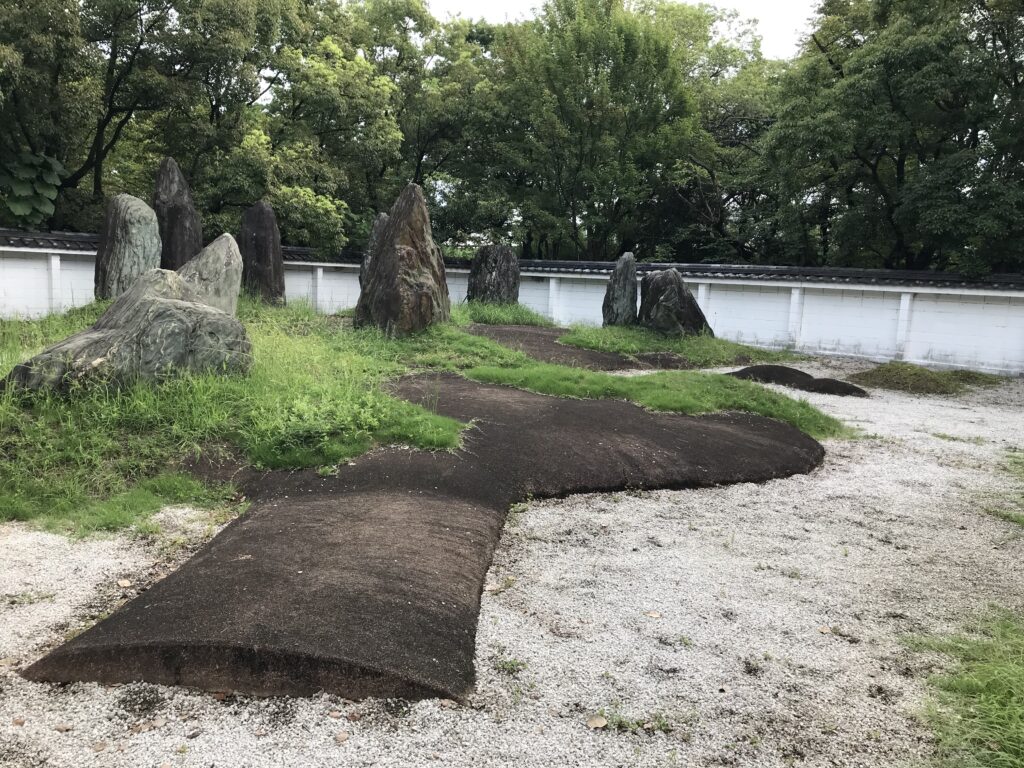
7,5,3で並ぶ緑泥片岩
奥に7個、真ん中に5個、手前に3個の巨石を横に配置して、おめでたい7・5・3を表現しています。雨風にさらされる石なので、黒っぽくなっています。もう少し手入れをすれば、緑泥片岩が持つ独特の深い緑の輝きを見られると思いますが、少し残念です。
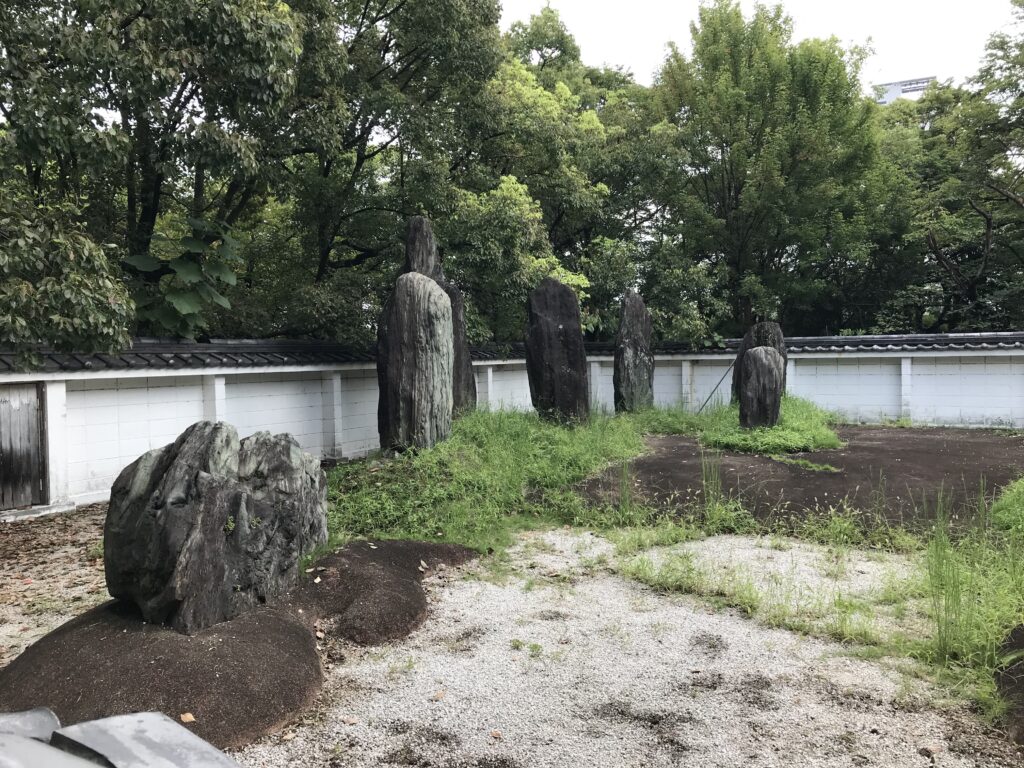
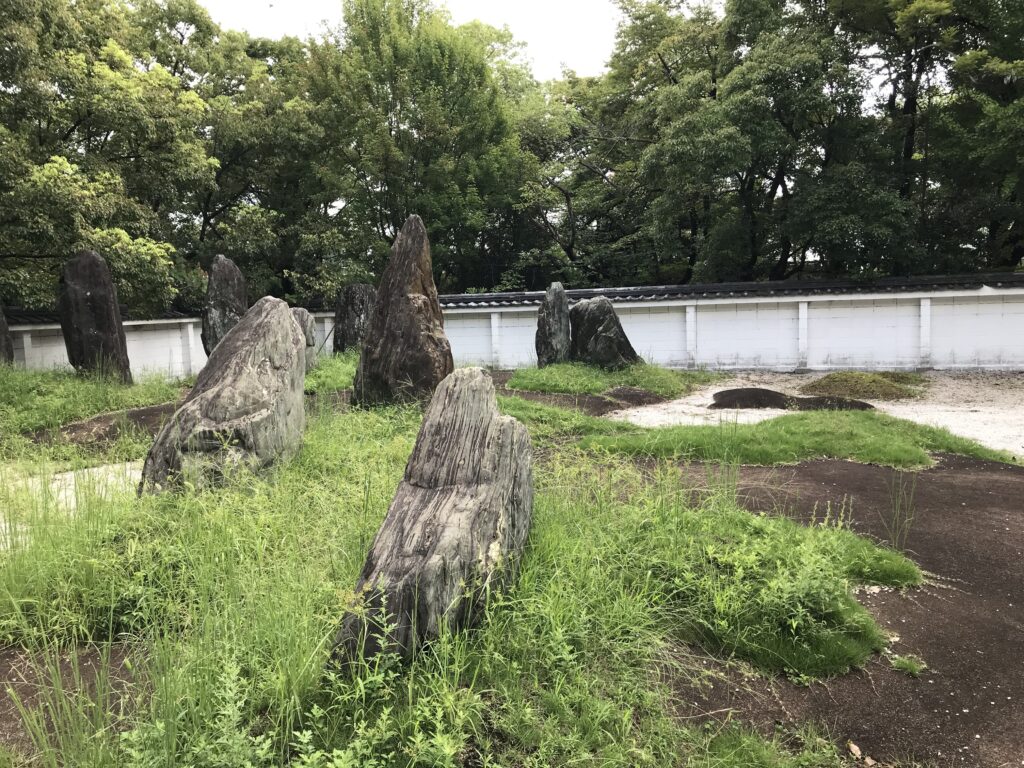
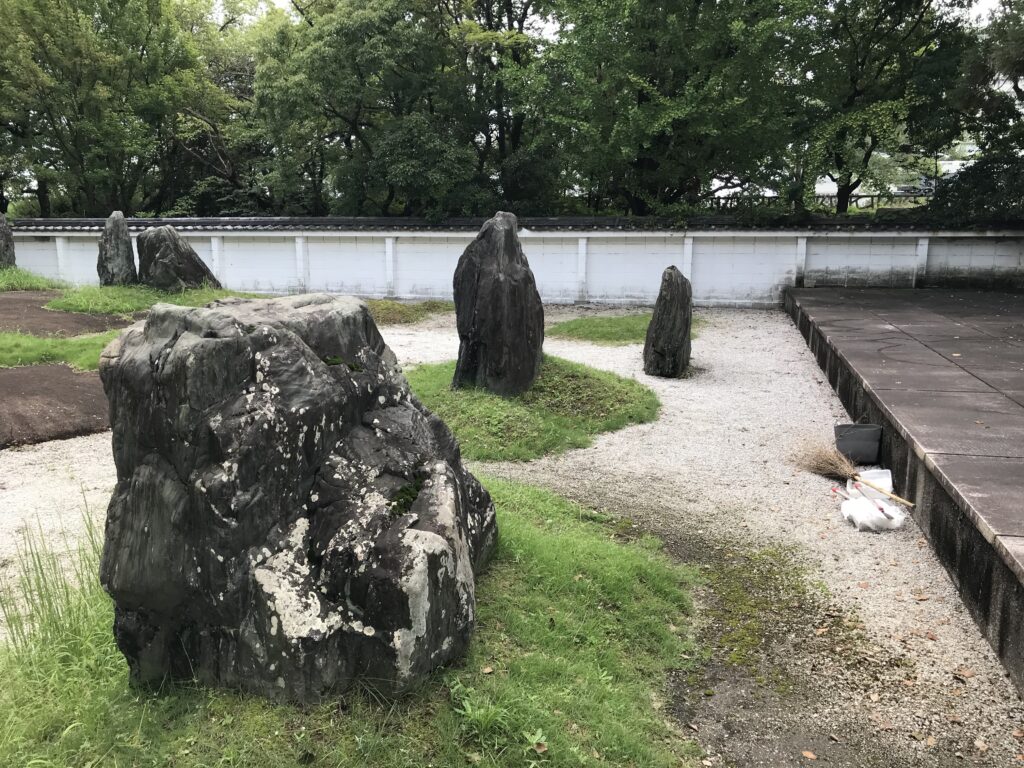
帰りに天守閣横の本丸庭園を見ておこうと思いましたが、改装工事中で、池の水もポンプで抜かれていました。今回は、極楽橋方面から帰るため本丸を北側から下っていきましたが、途中、豊臣秀頼と淀殿が最期を遂げたと言われる場所に建つ石碑にお参りしてから帰りました。(完)
大阪について学べる書籍
なにわなんでも大阪検定の教科書です。基本はこれで十分だと思います。
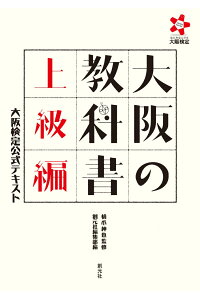
大阪の教科書 上級編 大阪検定公式テキスト [ 橋爪 紳也 ]
価格:2,090円
(2021/9/4 14:02時点)
感想(1件)
Shyusekitei Garden (Osaka city)
Osaka Castle has a hidden garden
I have previously written about Toyokuni Shrine, dedicated to Toyotomi Hideyoshi, located in Osaka Castle, and at the far right side of the main shrine there is a garden created by Shigemori Mirei, who is well known to many people. Unfortunately, no one comes to appreciate it, and the entrance is always closed. Still, the low wall allows visitors to view the garden through the fence.
The gardener is Mirei Shigemori
The name of this garden is “Shusekitei Garden. I think it means “Shu” in the character of “Hide”yoshi Toyotomi and the fact that “Ishi”yama Honganji Temple was originally located here, and that the garden is richly decorated with large stones, which is Mirei Shigemori’s specialty. I don’t think there are many guidebooks that introduce this garden, so I can only rely on the explanation on the rusty signboard hanging on the wall, but it is very hard to read.
Since it is a stone garden, the stones are placed in the shape of Mount Horai, and a large gourd, Hideyoshi’s symbol, is designed on the ground and arranged on the stones. The stone is said to be a green mud schist from Tokushima Prefecture, a huge stone that Mirei Shigemori had preserved for when he designed the best garden.
Green mud schist aligned in 7, 5, 3
Seven giant stones are placed horizontally in the back, five in the middle, and three in the front to represent the congratulatory 7, 5, and 3. The stones are exposed to rain and wind, so they have turned black. With a little more care, we would be able to see the unique deep green glow of the green mud schist, but it is a little disappointing.
On the way back, I wanted to see the Honmaru garden next to the castle tower, but it was under renovation and the water in the pond was being drained by a pump. This time, I went down from the north side of the castle to return from the Gokurakubashi Bridge, but on the way back, I paid a visit to the stone monument that stands at the place where Hideyori Toyotomi and Yododono are said to have met their final days. (End)
Shyusekitei Garden (Osaka city)
Le château d’Osaka possède un jardin caché
J’ai déjà écrit sur le sanctuaire Toyokuni, dédié à Toyotomi Hideyoshi, situé dans le château d’Osaka. À l’extrême droite du sanctuaire principal se trouve un jardin créé par Shigemori Mirei, qui est bien connu de beaucoup de gens. Malheureusement, personne ne vient l’apprécier, et l’entrée est toujours fermée. Néanmoins, le muret permet aux visiteurs de voir le jardin à travers la clôture.
Le jardinier est Mirei Shigemori.
Le nom de ce jardin est “Shusekitei Garden”. Je pense que cela signifie “Shu” dans le caractère de “Hide “yoshi Toyotomi et le fait que le temple “Ishi “yama Honganji était à l’origine situé ici, et que le jardin est richement décoré de grandes pierres, ce qui est la spécialité de Mirei Shigemori. Je ne pense pas qu’il existe beaucoup de guides présentant ce jardin, je ne peux donc me fier qu’à l’explication figurant sur le panneau rouillé accroché au mur, mais il est très difficile à lire.
Comme il s’agit d’un jardin de pierres, les pierres sont placées en forme du mont Horai, et une grande gourde, symbole de Hideyoshi, est dessinée sur le sol et disposée sur les pierres. On dit que la pierre est un schiste à boue verte de la préfecture de Tokushima, une énorme pierre que Mirei Shigemori avait conservée pour lorsqu’il a conçu le meilleur jardin.
Schiste à boue verte aligné en 7, 5, 3
Sept pierres géantes sont placées horizontalement à l’arrière, cinq au milieu et trois à l’avant pour représenter les 7, 5 et 3 de félicitations. Les pierres étant exposées à la pluie et au vent, elles sont devenues noires. Avec un peu plus de soin, nous pourrions voir l’éclat unique du vert profond du schiste à boue verte, mais c’est un peu décevant.
Sur le chemin du retour, je voulais voir le jardin Honmaru à côté de la tour du château, mais il était en cours de rénovation et l’eau du bassin était évacuée par une pompe. Cette fois, je suis descendu du côté nord du château pour revenir du pont Gokurakubashi, mais sur le chemin du retour, j’ai rendu visite au monument en pierre qui se trouve à l’endroit où Hideyori Toyotomi et Yododono auraient rencontré leurs derniers jours. (Fin)
